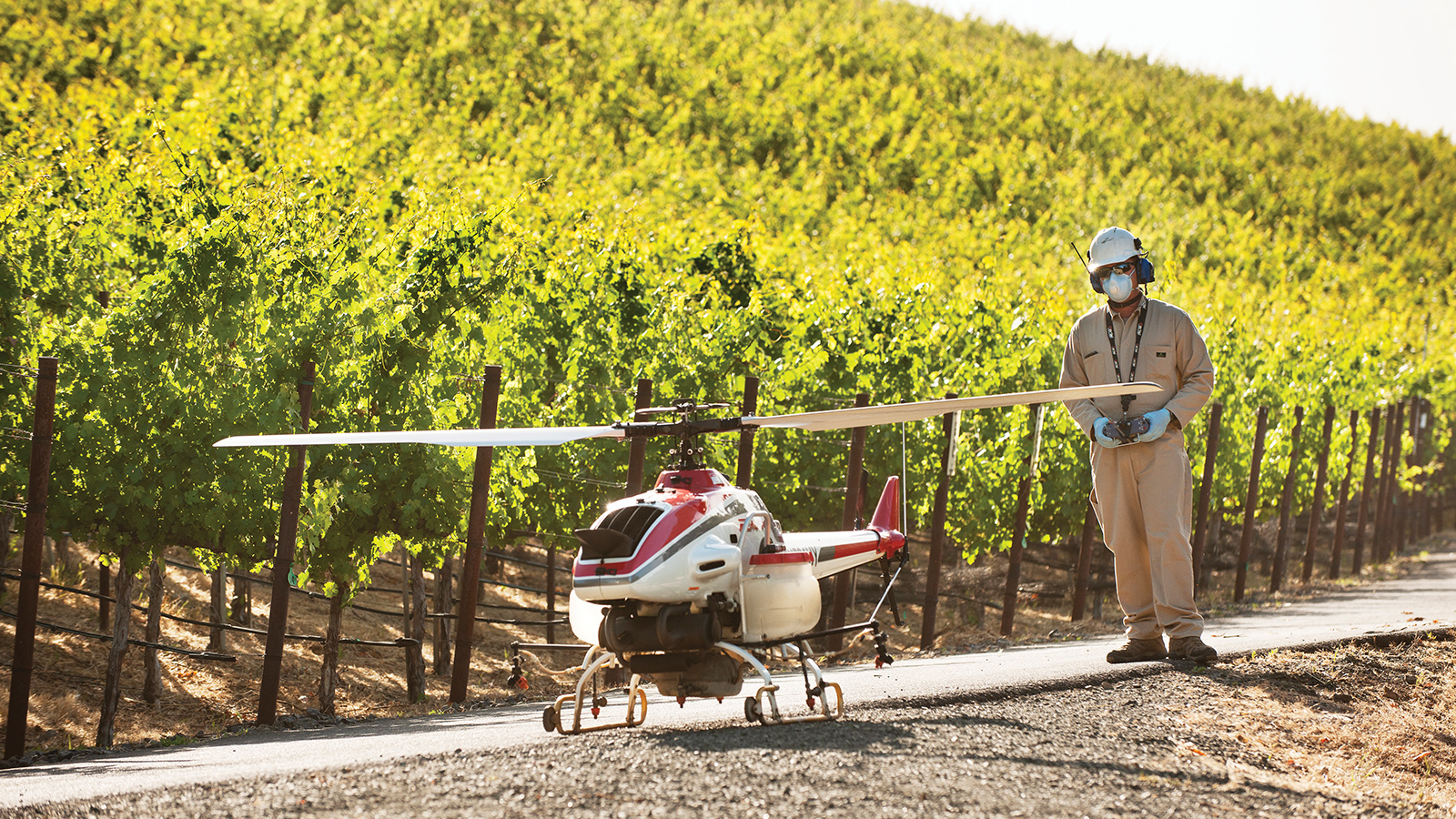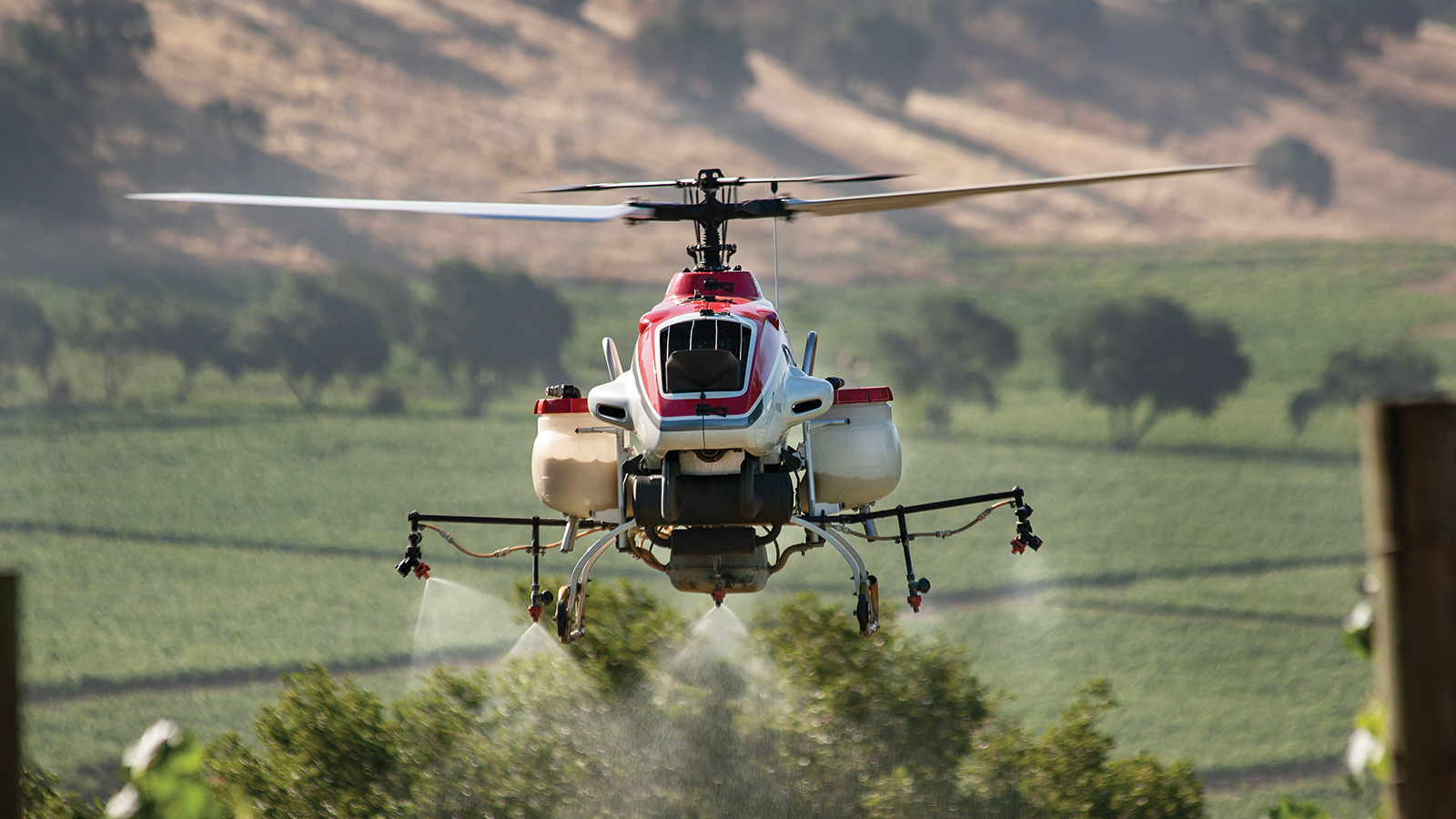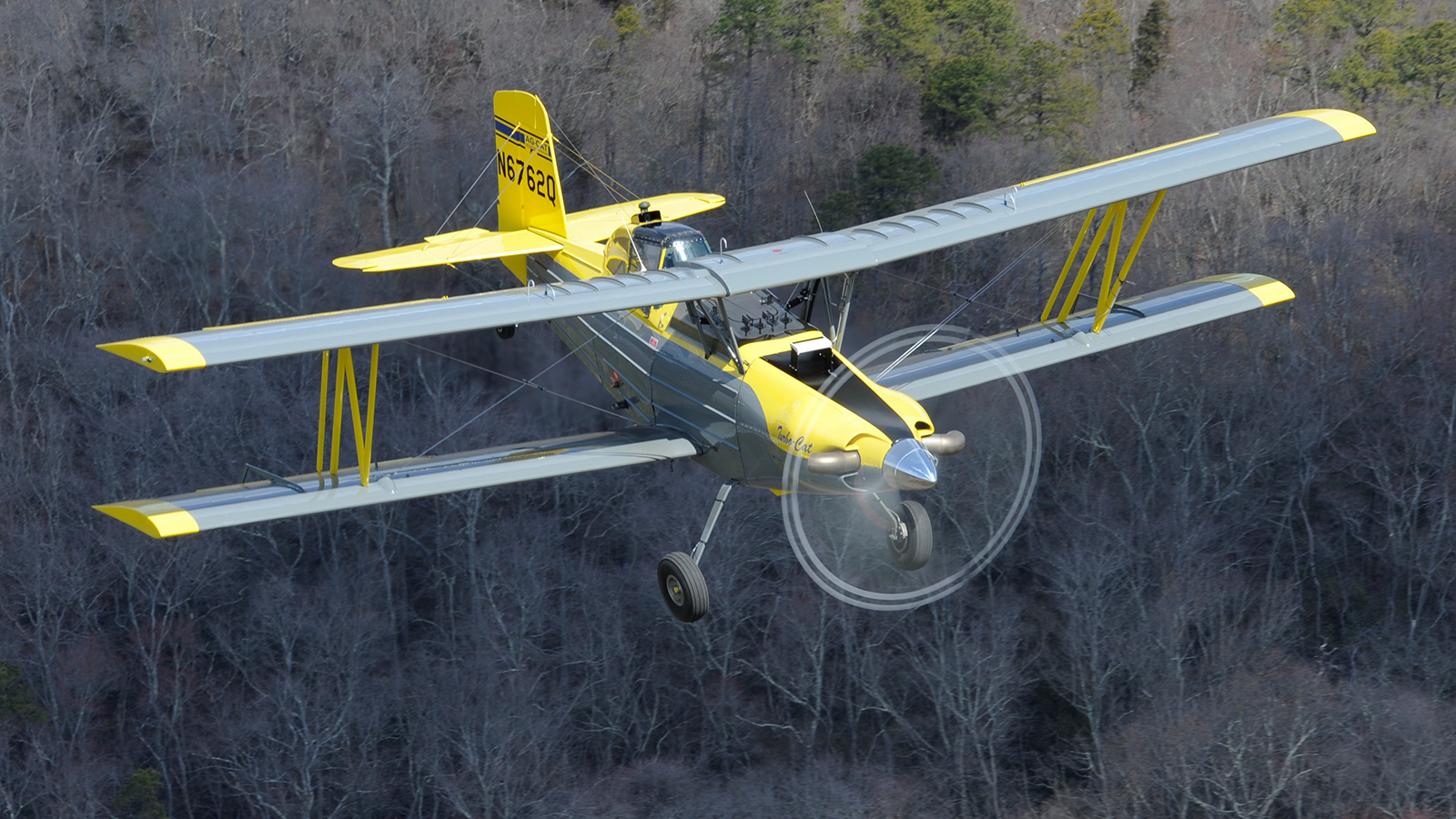The Farmer’s Air Force
By Jan Tegler|June 2019
Crop dusting with conventionally piloted aircraft is approaching its centennial. Now, with the challenge posed by drones, Jan Tegler looks at what could be in store for the next 100 years.
Credit the catalpa sphinx caterpillar for helping to launch a global industry.
On an August day in Ohio back in 1921, a U.S. Army pilot took off from an airfield near Dayton, his Curtiss JN-4 Jenny fitted with a small makeshift hopper (a metal container) and a release mechanism. The Jenny dropped low over an orchard, spreading powdered lead arsenate insecticide in an attempt to kill the caterpillars that were happily munching on the leaves of the catalpa trees, a hardwood used for railroad ties and fence posts.
It worked, and the technique caught on quickly with American farmers. On call to strike at insects, parasites and bacteria, crop dusters gained the nickname, the “Farmer’s Air Force.”
Today crop dusting is known as aerial application in the agricultural industry, and it’s one of the keys to modern productivity. “Ag” pilots flying a range of turbine and piston aircraft and helicopters skim 10 to 15 feet above fields. They swoop and pirouette to fly precise parallel lines over crops spraying protection chemicals, fertilizers and seed in one of the most demanding and potentially dangerous forms of aviation.
With the centennial of crop dusting approaching, aerial application pilots tell me they feel more relevant, capable and safer than ever in the vocation’s storied history. They could soon start feeling the pinch from a 21st-century competitor, however. Drone makers currently offer a range of small unmanned aircraft for aerial application but anticipate their wares could gradually displace ag pilots and their aircraft, although opinions vary about the feasibility of that.
In some concepts, rotorcraft drones would rise vertically from the perimeters of the fields they treat, spraying in precise patterns feet above crops, never venturing far from the remote pilots or automated support systems that accompany them. With no pilot aboard, drone makers say their aircraft are safer than manned aerial applicators. They also claim that drones can be more cost-effective and productive.
Drones might also be a solution to the looming pilot shortage that aerial application, like the rest of aviation, will face in coming years says Rafi Yoeli, CEO of Tactical Robotics Ltd., a drone maker in Yavne, Israel. “We’re looking at manned agricultural aircraft and helicopters and asking, what will happen to application for large fields that require a lot of material?”
The company’s Ag Cormorant prototype is a turbine engine-powered rotorcraft with enclosed rotors that takes off and lands vertically. Capable of carrying a 500-liter load, it is designed to fly autonomously for aerial application. With its size and power, it’s intended for large-scale applications and, as far as I could learn, is larger than any of the drones that are being flown for aerial application. Yoeli thinks that in five to seven years Tactical Robotics can “start earning money with this aircraft.”
Ag Cormorant is the result of a partnership announced in March between Tactical Robotics and Tel Aviv-based Adama Ltd. (a subsidiary of China National Chemical Corp.), which produces crop protection products for aerial and ground applications. The Ag Cormorant prototype first flew in February and is an adaptation of Tactical Robotics’ Cormorant prototype that made its initial flight in 2015. The Cormorant was designed for military and border security tasks.
Yoeli says Ag Cormorant is “aiming directly” at manned agricultural aircraft and helicopters “with everything it takes to actually replace a human pilot” and “provide the same level of safety.”
According to the U.S National Transportation Safety Board, there were 52 accidents in the U.S. involving aerial applicators in 2018 with eight fatalities, up one from 2017’s seven fatalities. The FAA’s most recent annual general aviation and air carrier activity survey shows that ag pilots flew 1.1 million hours in 2017. Using these numbers, the National Agricultural Aviation Association calculates 6.2 accidents per 100,000 flight hours for aerial applicators with a fatal accident rate per 100,000 flight hours of 0.65. That compares favorably with the FAA’s fatal accident rate for general aviation in 2016 (the most recent data) of 0.89 per 100,000 flight hours. Accident statistics for a drone like the Ag Cormorant don’t exist yet.
Size matters
Aerial application accelerated after World War II, spurred by development of a variety of insecticides, fungicides and herbicides and a swift increase in the average size of farms. Hopper size steadily increased to accommodate larger dry and wet loads — all the way up to the 3,028-liter hopper found on today’s piloted Air Tractor 802 planes.
Jim Hirsch is the president of Olney, Texas-based Air Tractor, the world’s leading producer of aerial application planes. He told me that his firm’s newest model, the AT-1002, will carry even more, up to 3,875 liters, once it completes FAA certification.
“It’s about acres [hectares] per minute,” Hirsch says. “Farmers rely on plant nutrient and pest control products being dispersed [as] quickly, efficiently and effectively as possible. We have the biggest, fastest airplane that hauls the biggest load with the widest spray swath.”
In the U.S., aerial application drones “are generally small currently and have very limited capability” says Steven Thomson, engineering programs and projects leader for the National Institute of Food and Agriculture, part of the U.S. Agriculture Department. With a background in aerial application crop protection materials as well as unmanned aerial systems, he views drones as “supplemental” to manned aircraft in the near to midterm.
Regulated under Part 107 of the FAA’s Federal Aviation Regulations, unmanned aircraft in the U.S. can fly no higher than 400 feet, no faster than 161 kph and must weigh less than 25 kilograms total. The weight restriction in particular severely limits their potential for aerial application.
Yamaha’s RMAX remotely piloted helicopter is the largest unmanned aerial application aircraft flying in the U.S., though significantly smaller than the Ag Cormorant. Brad Anderson, unmanned systems division manager for Yamaha Precision Agriculture, leads a three-person team, operating 10 RMAX helicopters under special FAA waivers in Napa, California. Yamaha’s waivers exempt the RMAX from FAA airworthiness requirements, exempt it from the requirement that the remote pilot have a commercial pilot’s license as ag pilots do and allows it to fly at its 64-kilogram weight. Since 2016 Anderson’s team has worked with a small group of vineyards, spraying fungicide for mildew prevention on wine grape crops.
Measuring 3.5-meters long (with rotor) and 1-meter tall, the RMAX is powered by a 2-cylinder gasoline engine. It carries a 16-liter payload. Anderson tells me over 2,000 are at work in Japan. “Forty percent of rice paddies are sprayed now by a Yamaha remotely piloted helicopter,” Anderson says. But he adds that drone regulation and the aviation and agriculture environment are different in Japan. Air traffic is far less dense and the rice paddies are smaller than America’s farm fields. Further, the Japan Civil Aviation Bureau doesn’t require certification of the RMAX.
While still focused on traditional aerial application planes, Air Tractor has made a foray into unmanned aircraft, Hirsch says. In May 2016, Air Tractor acquired Hangar 78 UAV, maker of the Yield Defender, a small autonomous quadcopter fitted with an infrared camera to shoot photos and videos of crops. But Hirsch notes that certification for large unmanned aerial application aircraft capable of carrying loads comparable to manned ag aircraft in the U.S. is “out of sight now, maybe 10 years away or more.”
The Ag Cormorant, yet to be certified or even tested, will carry up to 500 liters of wet or dry chemicals. Ag pilots ask: How could an unmanned aircraft capable of carrying just one-sixth of the load of the manned AT-802 match its efficiency? Yoeli has an answer: By employing an entirely different concept of operations.
“Imagine how this would change if instead of flying back and forth to a remote field to reload, these aircraft could, whenever necessary, land on a truck that’s less than a minute away and be off again after a 20-second auto-refill to continue working. That’s how Ag Cormorant will operate, so the ‘optimal design load’ for our case is no more than 500 kilograms,” he says.
Conventionally piloted aerial application
Pilots say their well-oiled operations are still more efficient than anything the drone world has conjured. Consider Downstown Aero Crop Service Inc. in the cranberry and blueberry country of New Jersey. Downstown operates six ag planes, including three Air Tractor-602s that each carry a 2,271-liter load. Four pilots and ground crew treat a variety of crops but primarily spray fungicide, insecticide and fertilizer on 1,500 hectares of cranberry and blueberry bogs.
In season, aerial application begins before dawn with Downstown’s aircraft flying to an 823-meter gravel runway in the midst of the bogs. There, pesticide-licensed ground crews mix fungicide to strictly enforced proportions. When the aircraft arrive, fungicide is pumped from mixing tanks into the hopper/tanks immediately in front of the Air Tractor’s cockpit. Simultaneously, a farm foreman gives the pilots computer thumb drives containing GPS coordinates for the bogs they will spray. The pilots insert the drives into GPS units in the aircraft and take off.
In “less than 90 seconds” the planes are over the cranberry or blueberry bogs, says Curt Nixholm, the company’s co-owner. Pilots descend and manually turn on their spray booms as they pass the perimeters at a little over 209 kph. Yoeli says Ag Cormorant will fly at 111 kph over fields and slower for application to orchards. A light bar mounted ahead of the AT-602’s cockpit using data supplied by the airplane’s GPS helps pilots line up for the parallel lines they will fly across the bogs. Their spray booms are calibrated prior to flights with pressures and nozzles adjusted to spray chemicals at the droplet size and rates called for on fungicide labels — usually 38 liters per half hectare — a rate that would rapidly empty the 500-liter Ag Cormorant.
The average flight lasts about 20 minutes per aircraft and the planes return to the landing strip. Nixholm says his AT-602s can refuel and take on more chemicals in three to five minutes. Yoeli estimates that the Ag Cormorant can be refilled in 20 seconds. Over a five-hour span, Nixholm’s planes will average 20 loads each. Carrying less than a quarter of the load the AT-602 carries, an Ag Cormorant would have to haul and apply more than 80 loads to achieve the same output.
The skill of ag pilots, averaging 19 years of experience according to the National Agricultural Aviation Association, allows them to spray accurately, minimizing drift — a byproduct of the aerodynamic vortices (swirling air) generated by the wingtips, propellers and rotors of ag aircraft and helicopters. Drift can result in damage to crops, wildlife and humans adjacent to fields being sprayed. Consequently U.S.-based aerial applicators are monitored for violations by the Environmental Protection Agency.
Nixholm and other ag pilots observe that drift patterns from unmanned aerial application aircraft have never been measured or studied. Yoeli says that the Ag Cormorant produces “zero vortices,” adding, “all we have is two cones of fast-moving air downward because our rotors are enclosed inside the fuselage.” But he admits that his claims are “based on estimates and simulations.” No aerial application testing of the Ag Cormorant has been done.
Robotic aerial application
Tactical Robotics CEO Yoeli describes aerial application with the Ag Cormorant as a robotic partnership. The autonomous drone pairs with a specialized “robotic truck” that automatically reloads the drone with chemicals and refuels it. One human supervisor will be required to operate the system. Once the drone has finished spraying a field, it lands on the robot truck, the supervisor drives it to the next field, and it takes off once more to autonomously spray.
Geo-fencing — a virtual GPS-defined perimeter for a real-world geographic area — along with electronic fencing, “poles in the ground around the perimeter of a field with some electronics,” will contain the Ag Cormorant within the boundaries of the area it sprays, Yoeli explains. Software yet to be created may also be used. Confining the AG Cormorant is vital because it eliminates the regulation and management needed to allow drones to fly in airspace between fields as manned aircraft do, Yoeli says. “We think this is a limitation that will exist for all unmanned agricultural aircraft.”
Yoeli says that Ag Cormorant will be more productive than manned ag aircraft because it will be able to spray by night as well as by day. But ag pilots already work at night in the U.S. Bruce Hubler, chief pilot for Valley Air in Caldwell, Idaho, says his operation has been spraying seed crops at night with aircraft-mounted flood lights “since at least 1969.”
Four years ago, Hubler and Valley Air began using night-vision goggles to spray after dark. “They actually increase your depth perception,” Hubler tells me. “I can see obstacles like power wires at night better than I can during the day.” He notes that aerial applicators in Southern California are also using the goggles now.
Hubler believes that drones can complement manned aerial application, appropriate for treating small corners of fields and crops near housing, buildings or forests — any area an ag aircraft struggles to spray safely and effectively. He also says that development of unmanned aerial applicators should come from within the existing community of aerial applicators. Hubler says he’s signed a nondisclosure agreement with a drone maker to develop “a cost-effective unmanned sprayer” capable of carrying 189 liters of chemicals — about one-tenth of the capacity of the average ag airplane.
It’s realistic, he observes, noting that the unmanned aircraft offered for aerial application so far cannot legally spray many chemicals at the rates specified by their labels because they lack capacity and booms capable of meeting the requirements.
‘
Yoeli concedes that the Ag Cormorant may not be able to spray chemicals at the volume manned ag aircraft can but explains that another factor governs the 500-liter capacity of the Tactical Robotics drone — the Missile Technology Control Regime.
The U.S. State Department describes the regime as “an informal political understanding among states that seek to limit the proliferation of missiles and missile technology.” Thirty-five countries adhere to the understanding, but the State Department says the regime “is not a treaty and does not impose any legally binding obligations on partners.”
Nevertheless, Yoeli says the Missile Technology Control Regime “places severe limits on the export of unmanned aircraft that can carry more than 500 Kg for more than 300 kilometers.” The restriction may be lifted in the future, he predicts, “but for now it’s an export-limiting factor.”
Cost and safety
Air Tractor’s Hirsch says the cost associated with developing unmanned aircraft capable of performing aerial application at scale along with the absence of any regulatory, legal or insurance framework are what’s keeping his company from creating its own aerial application drone.
“Buying an airplane like ours is $1 million to $1.7 million,” Hirsch says. “It’ll fly for decades, and we think the cost of a similarly capable drone would be significantly higher today.”
For comparison, Yamaha advertises the comparatively small RMAX for a price between $80,000 and $120,000.
The much larger, more capable Ag Cormorant has no price at this point. Yoeli says that its cost will be competitive with manned ag aircraft because it doesn’t carry a salaried pilot who must be insured and requires just one supervisor. That’s not to say it will be inexpensive.
“Admittedly a large investment is necessary,” Yoeli says, “both on the aircraft itself and the specialized truck, avionics and operation to achieve the fully automated robotic application that we have in mind.”
The Agriculture Department’s Thomson notes that while manned ag aircraft have a measurable safety record, no metric exists for a drone capable of carrying potentially poisonous chemicals. He adds that there is no data for the economics and efficiency of unmanned aerial application drones able to operate at the same scale as manned ag aircraft. Thomson thinks aerial application drones are most relevant for specialty crops or smaller fields.
“Ag aircraft will be there in the areas where they’re used as the predominant force for aerial spraying for years to come,” he concludes.
Related Topics
Uncrewed Aircraft“Farmers rely on plant nutrient and pest control products being dispersed [as] quickly, efficiently and effectively as possible. We have the biggest, fastest airplane that hauls the biggest load with the widest spray swath.”
Jim Hirsch, Air Tractor













